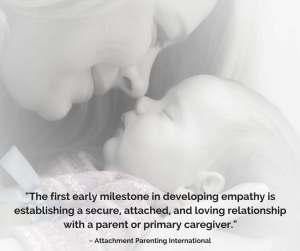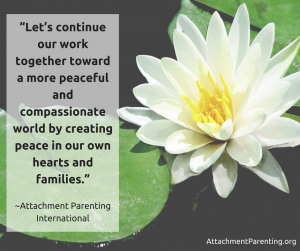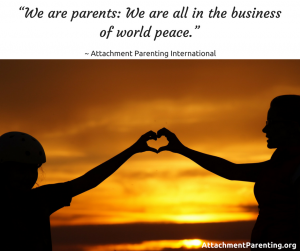Tag: nurturing peace
6 tips for talking politics with children
 The present political discourse around our nation is undeniable as it is inescapable. We can see, hear, and feel the tension on the airwaves and social media, in the energy that surrounds us and the air we breathe. It’s transcending beyond the political realm –into the social and our everyday encounters.
The present political discourse around our nation is undeniable as it is inescapable. We can see, hear, and feel the tension on the airwaves and social media, in the energy that surrounds us and the air we breathe. It’s transcending beyond the political realm –into the social and our everyday encounters.
Regardless of one’s convictions or political views, I’m certain that we can all agree that it seems as though the pot has been heating up for quite some time: The flames have been gradually rising and the water is now boiling…about to dangerously spill over.
I’m concerned about the “spilling over” effect of this political climate and its overall impact in our society — on our children.
Time to Listen
For the past year I’ve been following the political coverage on TV, reading articles from a variety of sources all across the political gamut, observing and engaging in social media discussions, and interacting with people from diverse political affiliations. Time and time again, I keep thinking in frustration: No one listens to one another, the door to collaboration and cooperation has been shut tight, and worst of all, there is little to no effort to try to understand each other’s point of view.
I would like to state clearly that I believe we don’t necessarily have to agree with one another, but it’s imperative that we at least listen and try to understand one another. Most of us want and wish the same for ourselves, our family, and our nation — though we clearly disagree on the avenues to accomplish it.
I wholeheartedly believe that listening and understanding are key components in creating tolerant and peaceful environments, both at home and beyond — in our communities and nation.
It feels as though there are two different, opposing camps on opposite sides of our country with the road between them nearly completely blocked. There is minimal communication and flow between the two camps.
It Starts At Home
As that image made itself into my mind one day, I chuckled because at times I feel like there are two opposing camps in my own house: my 11-year-old daughter and my 9-year-old son. Their personalities, interests, and habits are polar opposites. Yet, we are a family living under the same roof, and we share a special, sacred bond. To keep the peace and harmony in my house, I have to ensure the road between the two “camps” is wide open and well-traveled.
It has been a challenging task. I have been exploring different avenues to teach my kids to respect one another’s differences, to listen and keep the communication flowing, and to use their differences as a nurturing platform to strengthen one another, rather than diminish each other. We are a family — it’s imperative that we bridge our differences in spite and despite of them all. I wish the same for our nation and our children — because at the end of the day, we are one big family.
Attachment Parenting International supports collaboration and cooperation in the parent-child relationship, as well as nonviolent communication, listening and respect. Following such practices fosters understanding, harmony, and a strong bond – which in turn reduce tensions conflicts within the family structure.
In my role as a parent, I learned the importance of listening and trying my best to understand the true expressions of my kids’ behaviors –what thoughts and emotions are manifested through their behavior.
For example, as I observed my 12-month-old daughter become increasingly irritated and frustrated, I explored and suspected that her inability to verbally communicate contributed to her discontent. Seeking solutions, I embraced sign language to alleviate her inability to communicate effectively, and she had transformed and blossomed into a content, happy child.
With my younger son, I needed to understand that his needs and learning habits are vastly different than those of his older sister. Once I understood and accepted that, I was able to explore and implement different ways of approaching challenges that we encountered. Consequently, his schoolwork and overall behavior at home improved drastically.
Striving to understand why our children behave in certain ways and listening to them doesn’t necessarily mean we accept or support certain behaviors but rather, it means that we are better equipped to diffuse our frustrations and seek effective solutions. For instance, we understand that it is developmentally appropriate for a 12-month-old baby to shriek and throw a tantrum when they are frustrated due to their inability to communicate verbally and be understood. It gets us closer to minimizing conflicts and finding solutions.
Talking To Our Children About Politics, And Other Uncomfortable Topics
As a mother of 2 children and an individual who advocates for peaceful existence for our children, I’m concerned for our nation but, as importantly, about the inflamed political and social tone our kids are surrounded by.
 Conflicts and struggles can present great opportunities for learning and growth. We can seize the current political climate as an invitation to open the door to valuable and applicable conversations with our children.
Conflicts and struggles can present great opportunities for learning and growth. We can seize the current political climate as an invitation to open the door to valuable and applicable conversations with our children.
Here are some discussion points and contemplations that can help steer the conversation in the right direction — keeping in mind subject matter and language ought to be age-appropriate:
- Family Values — Clarify your own family values. It’s a good opportunity to emphasize your belief system, ideals, and priorities.
- Listen — Sometimes as parents we can get caught up in expressing our own views and feelings that we neglect to ask our children how they feel or think. Just ask them about their own thoughts and feelings. Make sure to create a comfortable space for them to form and share their own opinions, even if they differ from yours.
- Bullying –Most kids have likely been exposed to the past election cycle’s political debates, ads, and mudslinging. This can open the conversation about how and why some adults and kids mistreat or bully each other.
· What are some constructive ways kids can use to deal with everyday bullying scenarios at school or the playground?
· When kids witness a peer being bullied, how can they best diffuse the situation? - Honesty — Some delicate and divisive subjects, such as racism, terrorism, war, and poverty, can be challenging to discuss and uncomfortable. Our children expect and deserve our honesty. Children’s books and movies can be helpful tools to aid the conversation.
- Accept and respect differences — Our differences can strengthen or weaken us. It is important that we emphasize to children that different people come from different backgrounds and experiences in life and, as such, their values and points of views may be at odds with our own.
· What are some scenarios where children encounter differences?
· What are respectful and peaceful ways they can practice to bridge their differences? - Humor — Humor and laughter can be beneficial by lightening up a mood and reducing stress and anxiety. Political humor is one of the hallmarks of a free society. You can share with your kids age-appropriate political cartoons and watch comedy together.
· An important point to highlight: When does funny get to a point of not-so-funny-anymore, harsh, or even abusive?
Our kids observe and learn from our behavior as we are their most significant role models. As such, we ought to engage in introspection and investigate our own conduct — demonstrating to them that we are fostering a tolerant environment for them as well as our nation.
I can think of very few things that are more paramount than nurturing our children for a compassionate world. It’s our responsibility to illustrate to them that we know better, we can do and be better — individually and collectively — as one big family.
10 quotes from Martin Luther King, Jr., for peaceful parenting homes
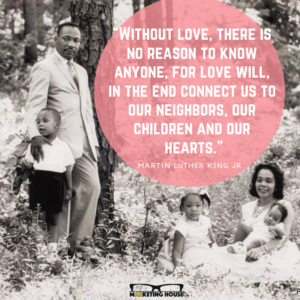 Today we remember Martin Luther King, Jr., the American minister-turned-civil rights activist whose legacy stretches even into the realms of parenting — if you consider that many of his quotes centered on peace and harmony can be aptly applied to homes that strive to raise their children with peace, warmth, trust, and nonviolence.
Today we remember Martin Luther King, Jr., the American minister-turned-civil rights activist whose legacy stretches even into the realms of parenting — if you consider that many of his quotes centered on peace and harmony can be aptly applied to homes that strive to raise their children with peace, warmth, trust, and nonviolence.
Here are 10 quotes of Martin Luther King, Jr., to keep in mind as you continue on your peaceful parenting journey:
- “Nonviolence is absolute commitment to the way of love. Love is not emotional bash. It is not empty sentimentalism. It is the active outpouring of one’s whole being into the being of another.”
- “Forgiveness is not an occasional act. It is a constant attitude.”
- “We must come to see that the end we seek is a society at peace with itself, a society that can live with its conscience.”
- “At the center of nonviolence stands the principle of love.”
- “World peace through nonviolent means is neither absurd nor unattainable. All other methods have failed. Thus we must begin anew. Nonviolence is a good starting point. Those of us who believe in this method can be voices of reason, sanity, and understanding amid the voices of violence, hatred, and emotion. We can very well set a mood of peace out of which a system of peace can be built.”
- “An individual has not started living until he can rise above the narrow confines of his individualistic concerns to the broader concerns of all humanity.”
- “There comes a time when one must take a position that is neither safe nor politic nor popular, but he must take it because his conscience tells him it is right.”
- “Those who are not looking for happiness are the most likely to find it, because those who are searching forget that the surest way to be happy is to seek happiness for others.”
- “He who is devoid of the power to forgive is devoid of the power to love.”
- “The time is always right to do the right thing.”
Becoming attached is the first milestone
Let’s continue creating peace
Parents are all in the business of world peace
Sharing gratitude on a nightly basis
 Before my children go to sleep at night, I have 3 questions that I ask them:
Before my children go to sleep at night, I have 3 questions that I ask them:
- What did you learn today?
- What was your favorite part of the day?
- What are you grateful for?
These questions have become a ritual for us as we have been doing it for years. We continue to do so even as we navigate the middle school days for my youngest and now are moving into the high school years for my oldest. I know we all look forward to this time of connection as it opens up a conversation that goes beyond the simple responses to those questions.
I have been surprised to find that the topic about gratitude is often the one that is discussed the most. There is an appreciation for all of us when we take the time to offer our thanks for something that happened during the day. My girls’ answers may be about a material item they received or a favorite food that they were able to eat — especially if it is a dessert — and I have found that is a practice for me to listen to their responses without judgement.
 It is a gift for each of us to pay attention to one another in a way that offers a willingness to receive whatever the other person has to offer. I am thankful for this opportunity to connect with my kids and for us to grow in our understanding that often it is the simple things in life that we are most grateful for.
It is a gift for each of us to pay attention to one another in a way that offers a willingness to receive whatever the other person has to offer. I am thankful for this opportunity to connect with my kids and for us to grow in our understanding that often it is the simple things in life that we are most grateful for.
Sometimes my girls give me the same answer for all 3 questions, and I am fine with this as I recognize that maybe being tired overcomes the desire to engage in conversation. I trust that they are offering what they can in the moment and that on a different day I may hear much more when they are ready to share. It is also possible that one event was the highlight of their day and the one thing that does answer all 3 of the questions. When I realize this, I am excited that they were able to engage in an activity that was filled with joy.
The time just before we fall asleep is one of my favorite moments of the day. I know that this can be a magical time when both girls are willing to open up with me and express what they are thinking or how they are feeling, which they might not do during any other time of the day. Every once and awhile, I have tried to get them to answer the questions over dinner only to be confronted with the comment that the day is not yet complete so I will just have to wait until later in the evening.
Over the years, I have grown to realize that this simple time with my kids is one of the best ways to engage in peaceful parenting as it reminds us what we are thankful for and encourages a dialogue that may not have taken place. I am amazed at all the events that they encounter in a day without me. I trust that they are navigating each experience with grace even when it is not so easy. I know that they will talk to me when needed.
As we move into a season where many families are expressing gratitude, I am reminded of how lovely it is for me and my kids to share our thanksgivings on a nightly basis.
What is peace to children?
 API hopes you have found AP Month 2016 to be enlightening and inspirational as we explored this year’s theme, “Nurturing Peace: Parenting for World Harmony.” On this last day of AP Month 2016, we bring you insight to what our children are internalizing as to what peace is:
API hopes you have found AP Month 2016 to be enlightening and inspirational as we explored this year’s theme, “Nurturing Peace: Parenting for World Harmony.” On this last day of AP Month 2016, we bring you insight to what our children are internalizing as to what peace is:
Emily, 8: “Calmness.”
Noemi, 8: “Peace means that everything is relaxing and calm.”
Emily, 10: “Quiet and relaxed.”
Violet, 10: “When people are calm, kind, peaceful, and respectful.”
Jacqueline, 7: “Love.”
Takumi, 7: “When I think of peace, I think of T.R.A.C.K.: Tolerance, Respect, Appreciate, Care, and Kindness. So if we have TRACK in heart, we can stay in peace.”
Zaiah, 10: “It is not war. It’s kindness. It’s being kind to each other. Peace is showing love to one another. Peace is having gratitude. Peace is love and gentleness.”
Remy, 14: “Peace to me means no child anywhere would know violence.”
Sophie, 5: “Peace means that I love my sisters.”
Rachel, 10: “Like not fighting, like what Martin Luther King, Jr., did with having people come together in peace, between different people. Like quietness and being calm.”
Thank you to Rachel, for suggesting this post for AP Month 2016. She is a 4th grader at Sandy Creek Public Schools in Clay County, Nebraska, USA. Contributions came from children around the world, thanks to the wide reach of the parents who volunteer with API.
Nathan, 5: “Not fighting. We should all work together as a team. No one, boy or girl, is better than another. We are all special.”
Camille, 18: “Peace is love, patience, truthfulness, kindness, and gentleness, and something we must achieve together.”
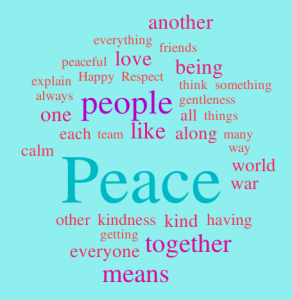 Luke, 10: “Peace is not war. It is peace. It is being kind to one another. It is sticking together, staying together as the world.”
Luke, 10: “Peace is not war. It is peace. It is being kind to one another. It is sticking together, staying together as the world.”
Ethan, 8: “Happy and the only way people can get along.”
Alexandra, 11: “Peace is something that is almost impossible. There are always fights, problems, and stress. Big things like wars and small things like bickering always happen. But every once in a while, the world may have a minute of peace.”
Shelly, 11: “Everyone getting along and respecting one another.”
Daniel, 14: “All nations and religions will be tolerant of one another.”
Anna, 8: “Peace means to get along with everyone no matter what they look like.”
Juliana, 13: “Peace is everyone working together and no war. People helping people.”
Brook, 10: “It means not fighting and being kind.”
Bennett, 9: “Peace means no terrorism, no war, and no murder.”
Harrison, 11: “Harmony.”
Oliver, 9: “Peace means that the people get together and have a good time, and get through the bad times, and have a bright and sunny and peaceful world.”
Samantha, 13: “Peace is hard to explain since it has many interpretations and definitions, as well as having peace in many shapes and forms. However, the best way to explain it is when people learn respect, tranquility, simplicity, and equality within everything.”
Miranda, 9: “People getting along and the world being a happy place for everyone. Everybody is friends and doesn’t hate each other ever.”
Coby, 11: “When people aren’t angry and people are friends.”
Luke, 14: “Rather than fight each other, orcs and humans team up.”
Hiroto, 3: “Peace? I like peace. Mama, what’s a peace? I like peace. Yes, I accomplished!”


